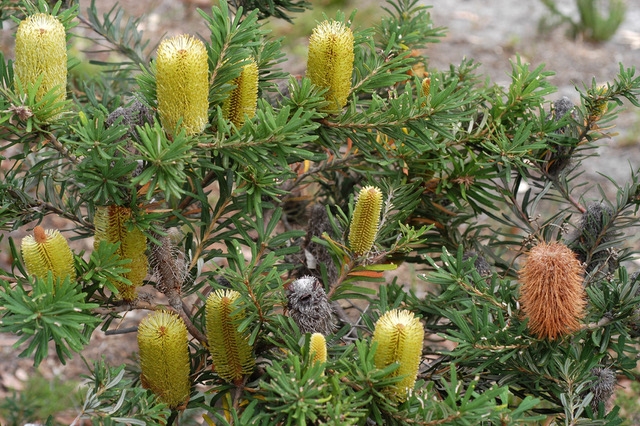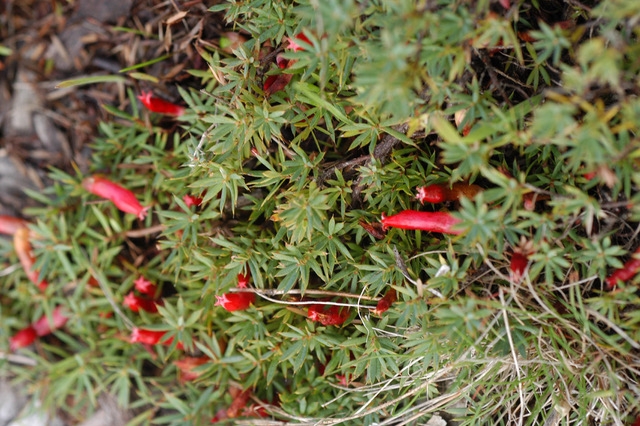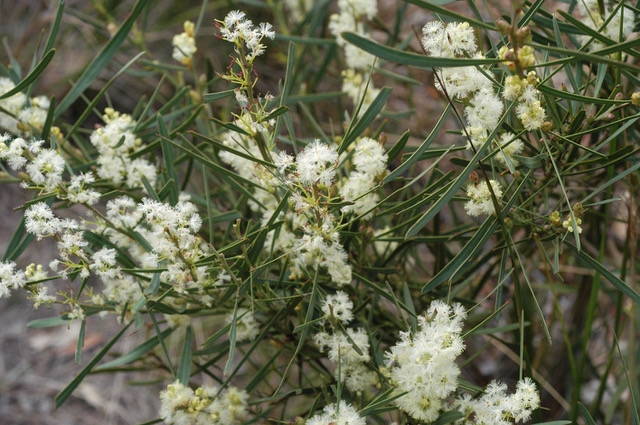A very dry autumn has left the bushland looking a little stressed, and the ants seem to have taken over.
I have never seen so many ant holes as there are this year, however there are still some gems to be seen when you go on your nature rambles.
Looking especially lovely are:
Silver Banksia, Banksia marginata, is the only species of banksia that occurs naturally in the district. It copes well with salt-laden winds as a shrub, but further inland may grow to three metres. The leaves, 15 cm long, are simple, tough and leathery arranged alternatively or whorled with smooth or toothed edges, and the new growth has attractive bronze foliage. The under surface of the leaf is covered with dense short woolly hairs (hence Silver Banksia). The flowers can be found throughout the year but are mainly from February to September.
 Silver Banksia
Silver Banksia
The flower is a cylindrical mass of sessile flowers densely arranged on a woody axis, ranging in size and colour from light pale-green, light yellow, tawny brown and dark grey-brown. The cones of the banksia may remain on the plant for several years. The Silver Banksia makes a sturdy ornamental windbreak and is visited by birds and bees for their nectar. The Aborigines made sweet drinks from the flowers, and paint brushes from the dried stamens.
Horny Cone-bush, Isopogon ceratophyllus, is a stiff, rounded dwarf shrub, which has prickly, rigid, light-green leaves to 80 mm long, segmented, narrow and triangular. The flower buds are an attractive reddish colour and can be seen now in the bush.

Horny Cone-bush
The flowers are borne in globular cones that are closely surrounded by the leaves and the fruit is a small hairy nut, about 20 mm in length. This plant is common in the district and can be seen in sandy heathlands, open forest and woodlands. It can tolerate dryness once established and is only found in Australia.
Cranberry Heath, Astroloma humifusum, is a dense, many-branched mat-forming shrub up to 40 cm across, with bluish-green, lance-shaped leaves with a sharp point. It has narrow, tubular, deep-red flowers, seen much of the year.
 Cranberry Heath
Cranberry Heath
They are generally single and hidden amongst the leaves. After flowering, pale-green to reddish berries form, which are edible. The fruit has a ‘store’ which protects the seed. It is found in redgum woodland, tea-tree heath and open forest. It likes well-drained soils, tolerates dry periods and grows well in rockeries and embankments.
The Sweet Wattle, Acacia suaveolens, forms large attractive stands of 1.3–2.5 m open spreading shrubs which are well-displayed at Fraser Avenue, Anglesea. The foliage is a bluish-green with stiff erect stems. The long, narrow phyllodes have a prominent midrib and sharp point. There are two nectar glands on the edge of the phyllode—one at the base and one at the top. The flowers, a creamy-yellow, are aromatic, and appear in late autumn to early winter.
 Sweet Wattle
Sweet Wattle
When the flowers finish, pale-bluish seedpods develop, which are semi-transparent to begin with, but as the pod matures it becomes hard and dark brown, then twists, splitting along the margin to release the black, shiny seeds. The twisted empty seedpods can remain on the plants for many months. This wattle can form on attractive ornamental screen and/or windbreak. It responds to pruning after flowering.
When out and about, look down at the ground and you may see some fungi, the main recycling agents for most of the dead plant material in the bushland. These cause nutrients and minerals to be released so that many of our native plants do not become extinct.
References: Flowers of Anglesea and Aireys Inlet, 2009, Ed. M. MacDonald
Anglesea – A Natural History Study
Flora of the Otway Plain and Ranges 2, 2013, Enid Mayfield
Flora of Melbourne 3rd Ed.
Philippa Hesterman
Photos: courtesy of Margaret MacDonald.